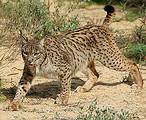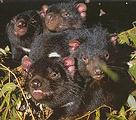 全球哺乳類動物正籠罩在滅絕的陰影下,根據最新的科學調查,每4種哺乳類就有1種面臨永久消失的危機,調查結果於10月5日在巴塞隆納的世界自然保育聯盟(IUCN)全球保育會議中發表。
全球哺乳類動物正籠罩在滅絕的陰影下,根據最新的科學調查,每4種哺乳類就有1種面臨永久消失的危機,調查結果於10月5日在巴塞隆納的世界自然保育聯盟(IUCN)全球保育會議中發表。
這項為IUCN「瀕危物種紅皮書」所作的研究,是首次針對地球上全部的5487種哺乳類進行評估,目前發現已知至少1141種已受到絕種威脅。從1500年以來,至少有76種哺乳類已然滅絕。
而實際情況可能更為嚴重,因為其中的836種哺乳類被列為「資料不足」,若得到更充分的資訊,可能會有更多種類被科學家認定有滅絕危機。
 哺乳類保育報告即將刊登在《科學》期刊上,首席作者是國際保育協會(Conservation International)的許帕(Jan Schipper)指出,「受威脅的哺乳動物數目,實際上可能高達36%。」
哺乳類保育報告即將刊登在《科學》期刊上,首席作者是國際保育協會(Conservation International)的許帕(Jan Schipper)指出,「受威脅的哺乳動物數目,實際上可能高達36%。」
他也表示,「這告訴我們,從研究出發的保育行動是未來的首要工作,除了增加對目前未知物種的資料來評估威脅,還要針對受威脅的物種及族群,調查復育的方法。」
這項調查全球哺乳類的計畫,得到超過130個國家,共1800位以上的科學家協助。調查顯示保育行動能夠挽救在滅絕邊緣的物種,而目前5%的受威脅哺乳類在野外有恢復的跡象。
 調查結果也顯示有188種哺乳類屬於絕種風險最高的「極危(Critically Endangered)」等級,包括伊比利亞猞猁(或稱林拽,Lynx pardinus),目前族群中的成年個體僅有84至143隻,而且持續減少,原因是缺乏了主要獵物歐洲穴兔(Oryctolagus cuniculus)。
調查結果也顯示有188種哺乳類屬於絕種風險最高的「極危(Critically Endangered)」等級,包括伊比利亞猞猁(或稱林拽,Lynx pardinus),目前族群中的成年個體僅有84至143隻,而且持續減少,原因是缺乏了主要獵物歐洲穴兔(Oryctolagus cuniculus)。
被列為「極危」等級的種類中,有29種可能已經無法挽回,例如一種在古巴的囓齒動物,小地烏提亞硬毛鼠(Mesocapromys sanfelipensis),已有近40年未被發現。
被列為「瀕危(Endangered)」等級的有近450種,包括塔司馬尼亞袋獾(Sarcophilus harrisii),因為致命的臉部感染性癌症,全球族群在過去10年下降超過60%,被從「無絕種危險」升高為「瀕危」。
棲地消失與破壞影響了全球40%的哺乳類。情況最嚴重的是中南美、西非、東非、中非、馬達加斯加、南亞與東南亞。過度獵補是大型哺乳類消失的原因,尤其在東南亞,還有非洲與南美的部份地區。
 全球哺乳類調查也顯示,在協調的保育行動努力下,物種可以得到復育。從「在野外滅絕」被降低為「瀕危」的黑足鼬(Mustela nigripes),就是在1991-2008年間,由美國漁業暨野生物管理局成功重新引進西部8州與墨西哥。
全球哺乳類調查也顯示,在協調的保育行動努力下,物種可以得到復育。從「在野外滅絕」被降低為「瀕危」的黑足鼬(Mustela nigripes),就是在1991-2008年間,由美國漁業暨野生物管理局成功重新引進西部8州與墨西哥。
倫敦動物協會保育部主任貝利(Jonathan Daillie)博士指出,「我們已經由保育知識的黑暗時代走出,過去我們所根據的資料受限於少數幾種動物。未來我們會擴展對物種知識的視野,才能用更客觀、更具代表性的方法,與政策制定者溝通並給予協助。」
The world's mammals are in the grip of an extinction crisis, with almost one in four at risk of vanishing forever, according to the latest scientific assessment revealed at the International Union for the Conservation of Nature's World Conservation Congress, which opened Sunday in Barcelona.
The new study conducted for the IUCN Red List of Threatened Species for the first time assessed all of the 5,487 mammals on Earth and found that at least 1,141 of them are known to be threatened with extinction. At least 76 mammals have become extinct since the year 1500.
The real situation could be much worse as 836 mammals are listed as Data Deficient. With better information, scientists may classify even more species as being in danger of extinction.
"The reality is that the number of threatened mammals could be as high as 36 percent," said Jan Schipper of Conservation International, lead author in a forthcoming article on the mammal assessment in the journal "Science."
"This indicates that conservation action backed by research is a clear priority for the future, not only to improve the data so that we can evaluate threats to these poorly known species, but to investigate means to recover threatened species and populations," said Schipper.
The project to assess the world's mammals was conducted with help from more than 1,800 scientists from over 130 countries. The assessment also indicates that conservation can bring species back from the brink of extinction, with five percent of currently threatened mammals showing signs of recovery in the wild.
The results show 188 mammals are in the highest threat category of Critically Endangered, including the Iberian Lynx, Lynx pardinus, which has a population of between 84 and143 adults and has continued to decline due to a shortage of its primary prey, the European rabbit, Oryctolagus cuniculus.
It may be too late to save the 29 species that have been flagged as Critically Endangered Possibly Extinct, including a rodent once found in Cuba, the Little Earth Hutia, Mesocapromys sanfelipensis, which has not been seen in nearly 40 years.
Nearly 450 mammals have been listed as Endangered, including the Tasmanian devil, Sarcophilus harrisii, which was moved from the category of Least Concern to Endangered after the global population declined by more than 60 percent in the last 10 years due to a fatal infectious facial cancer.
Habitat loss and degradation affect 40 percent of the world's mammals. It is most extreme in Central and South America, West, East and Central Africa, Madagascar, and in South and Southeast Asia. Over harvesting is wiping out larger mammals, especially in Southeast Asia, but also in parts of Africa and South America.
The assessment of the world's mammals shows that species can recover with concerted conservation efforts. The black-footed ferret, Mustela nigripes, moved from Extinct in the Wild to Endangered after a successful reintroduction by the U.S. Fish and Wildlife Service into eight western states and Mexico from 1991-2008.
"We are now emerging from the dark ages of conservation knowledge, when we relied on data from a highly restricted subset of species," says Dr Jonathan Baillie, director of conservation programs at the Zoological Society of London. "In the future we will expand the scope of our species knowledge to include a far broader range of groups, thus informing and assisting policy makers in a hugely more objective and representative manner."
全文及圖片詳見:ENS






